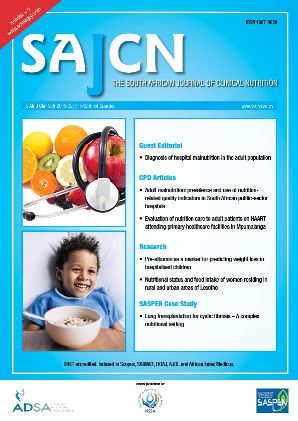Nutritional status and food intake of women residing in rural and urban areas of Lesotho
Abstract
Objective: The socio-demography, anthropometry and food intake of women residing in rural and urban areas of Lesotho were determined.
Design: Cross-sectional survey.
Setting: Basotho women from four randomly selected villages in Maseru and Berea, which includes both urban and rural areas.
Subjects: A total of 452 women were included in the study.
Outcome measures: Socio-demographic information was collected using a structured questionnaire completed in an interview with each participant. Standard methods were used to determine anthropometric measurements, while usual food intake was determined using a short unquantified food frequency questionnaire.
Results: A large percentage of participants were unemployed with a significantly higher percentage in urban compared with rural areas (65.5 vs. 49.2%; CI 6.8%; 25.4%). A higher percentage of urban than rural participants had a BMI ≥ 30 kg/m2 (53.5 vs. 44.4%, respectively) and waist circumference ≥ 88 cm (62.7 vs. 54.1%, respectively). For both rural and urban participants, stiff maizemeal porridge was commonly consumed with all meals, often with moroho (cooked green leafy vegetables). Although a variety of vegetables (onions, cabbage, pumpkin, tomatoes, turnips and potatoes) were frequently eaten by most participants, quantities of intake were not determined. Protein sources consumed almost every day by more than 0% of all participants were dried beans. Chicken, eggs and full cream milk were consumed significantly more frequently by urban participants. Significantly more urban participants had access to a variety of fruits and vegetables, and they were also more likely to consume foods such as polony, russians (sausage containing pork and beef), sausage, sweetened drinks, mayonnaise and margarine more frequently than rural participants.
Conclusions: A nutrition transition associated with the frequent intake of processed, sugary and high-fat foods was identified in urban participants. These unhealthy dietary practices may lead to an increased risk of obesity and poor health outcomes. The development of culturally acceptable and relevant interventions is thus recommended.
The full article is available at http://dx.doi.org/10.1080/16070658.2017.1415783
The SAJCN does not hold itself responsible for statements made by the authors.


